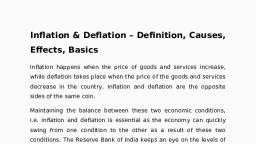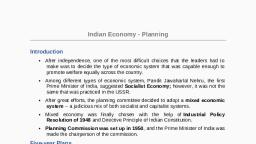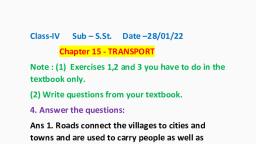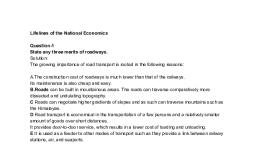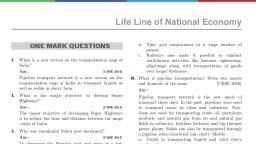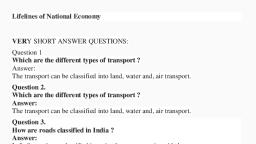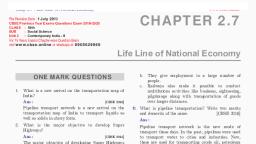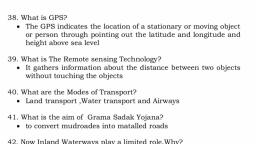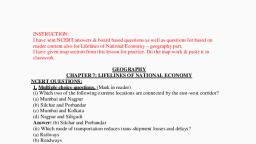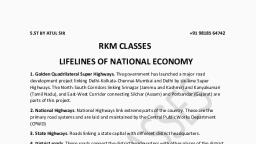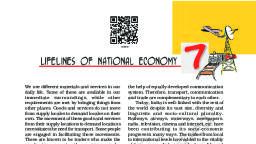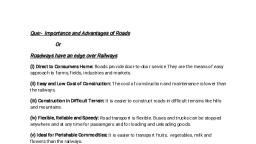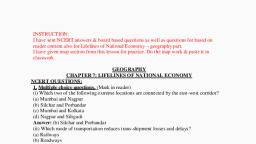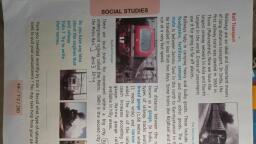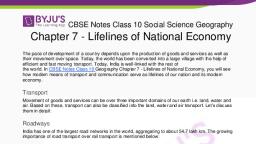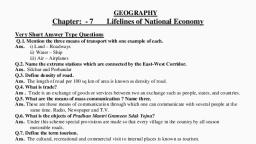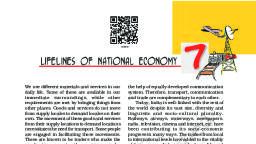Page 1 :
ECONOMIC GROWTH, The term economic growth is defined as the process whereby the country’s real national and per capita income increases over a long period of time. This definition of economic growth consists of the following features of economic growth:, Economic Growth implies a process of increase in National Income and Per-Capita Income. The increase in Per-Capita income is the better measure of Economic Growth since it reflects increase in the improvement of living standards of masses., Economic Growth is measured by increase in real National Income and not just the increase in money income or the nominal national income. In other words the increase should be in terms of increase of output of goods and services, and not due to a mere increase in the market prices of existing goods., Increase in Real Income should be Over a Long Period: The increase of real national income and per-capita income should be sustained over a long period of time. The short-run seasonal or temporary increases in income should not be confused with economic growth., Increase in income should be based on Increase in Productive Capacity: Increase in Income can be sustained only when this increase results from some durable increase in productive capacity of the economy like modernization or use of new technology in production, strengthening of infrastructure like transport network, improved electricity generation etc., ECONOMIC DEVELOPMENT, Economic development is defined as a sustained improvement in material well being of society. Economic development is a wider concept than economic growth. Apart from growth of national income, it includes changes – social, cultural, political as well as economic which contribute to material progress. It contains changes in resource supplies, in the rate of capital formation, in size and composition of population, in technology, skills and efficiency, in institutional and organizational set-up. These changes fulfill the wider objectives of ensuring more equitable income distribution, greater employment and poverty alleviation. In short, economic development is a process consisting of a long chain of interrelated changes in fundamental factors of supply and in the structure of demand, leading to a rise in the net national product of a country in the long run. 29 Economic Growth and Economic Development ECONOMICS MODULE - 2 Current challenges before the Indian Economy Notes, The economic growth is a narrow term. It involves increase in output in quantitative terms but economic development includes changes in qualitative terms such as social attitudes and customs along with quantitative growth of output or national income., Economic development without growth is almost inconceivable. The comparison between the two concepts is given in the following table:, COMPARISON CHART: ECONOMIC GROWTH VS. ECONOMIC DEVELOPMENT, Characteristics of an Underdeveloped Countries/ Developing countries:, Characteristic # 1. Low Level of Income:, Underdeveloped countries are maintaining a very low level of income in comparison to that of developed countries. The per capita incomes of these groups of countries are extremely low if we compare it with that of developed countries. Moreover, inequality in the distribution of income along with this low level of income worsens the situation in these economies to a disastrous level., Characteristic # 2. Mass Poverty:, Existence of chronic mass poverty is another characteristic of underdeveloped economies. This problem of poverty arises not due to any temporary economic maladjustment but arises mainly due to existence of orthodox methods of production and social institutions. The degree of poverty in these economies gradually increases due to increase in its size of population, growing inequality in income and increasing price level., ADVERTISEMENTS:, Nearly 76.8 per cent of the world populations are living in those underdeveloped or developing countries of the world, enjoying only 15.6 per cent of total world GNP.’ Iii these countries, majority of the population are living below the poverty line., Characteristic # 3. Lack of Capital Formation:, Developing or underdeveloped countries of the world are suffering from poor rate of capital formation. As the level of per capita income in these countries is very low thus their volume and rate of savings are also very poor. This has resulted lack of capital formation and which is again responsible for low rate of investment in these countries., As for example, the rate of investment in countries like India and Pakistan is lower than even 10 per cent but, on the other hand, the same rate is ranging between 15 to 30 per cent in developed countries like U.S.A., Canada etc. Thus this poor rate of capital formation is one of the major obstacles towards the path of development of these underdeveloped countries of the world., Characteristic # 4. Heavy Population Pressure:, The underdeveloped countries are also characterised by heavy population pressure. The natural growth rate of population in these countries is very high due to its prevailing high birth rate and falling death rate. This excessive population pressure has been creating the problem of low standard of living and reduction in the average size of holding., ADVERTISEMENTS:, This has also resulted in low rate of capital formation in these countries. The population in these countries is increasing by 2 to 3 per cent per annum which has created various problems like scarcity of agricultural land, small size of holding, problem of unemployment, food crisis, poverty etc., Characteristic # 5. Agricultural Backwardness:, The underdeveloped countries are also suffering from agricultural backwardness. Although being the most important sector, agricultural sector in these countries remains totally underdeveloped. But what is more peculiar is that these countries are depending too much on this agricultural sector., Nearly 60 to 70 per cent of the total population of these countries is depending on agriculture and about 30 to 40 per cent of the total GNP of these countries is generated from agricultural production. Agricultural productivity in these countries remained still very poor in spite of its great importance., In these underdeveloped countries, agriculturists are still following traditional methods and are applying modernised techniques on a very limited scale., Characteristic # 6. Unemployment Problem:, Excessive population pressure and lack of alternative occupations have resulted in huge unemployment and underemployment problem in these underdeveloped countries. In the absence of growth of alternative occupations both in the secondary and tertiary sector of these countries, this increasing number of population is being thrown on land to eke out their living from agricultural sector., This sort of increasing dependence on agricultural sector leads to disguised unemployment or under-employment in these economies to a large scale. Moreover, problem of educated unemployment in these economies is also increasing gradually day by day due to lack of industrial development., Characteristic # 7. Unexploited Natural Resources:, For maintaining a rapid pace of economic growth in these underdeveloped countries, possession of different types of natural resources in sufficient quantity and its utilisation are very important. But under-developed countries are either suffering from scarcity of raw materials or from un-exploited natural resources of its own., If we look at the endowment position of these countries then we can see that some of the underdeveloped countries are having natural resources like land, water, minerals, forest etc. in sufficient quantity but these resources remain largely under-utilized or even untapped due to various difficulties faced by these countries., These difficulties include inaccessibility of the region, shortage of capital, lack of proper attention, primitive technology, transport bottlenecks and small extent of the market. Thus by utilising its natural resources, underdeveloped countries can develop their economies with minimum initiative of their own., Characteristic # 8. Shortage of Technology and Skills:, Underdeveloped countries are facing low level of technology and acute shortage of skilled manpower’s. Poor technology and lower skills are responsible for inefficient and insufficient production which leads to poverty of masses. The pace of economic growth in these countries is very slow due to application of poor technologies., But the application of modern sophisticated technology both in agricultural and industrial sector is of utmost need in these countries. This requires sufficient amount of capital, technological advancement and training., Characteristic # 9. Lack of Infrastructural Development:, Lack of infrastructural development is a common feature of underdeveloped countries. In respect of transportation, communication, generation and distribution of electricity, credit facilities, social overheads etc. these countries are very much backward than most of the developed countries. Thus due to inadequate infrastructural facilities, the pace of economic development in these countries are very slow., Characteristic # 10. Lack of Industrialization:, Underdeveloped countries are characterized by lack of industrial development. The pace of industrialisation in these countries is very slow due to lack of capital formation, paucity in the supply of machinery and tools and also due to lack of initiative and enterprise on the part of people of these countries., ADVERTISEMENTS:, In spite of having huge potential for industrial development, these countries could not develop the industrial sector on a sound footing. Moreover, whatever industrial development that has been achieved by these countries are very much restricted only to some limited areas., Characteristic # 11. Lack of Proper Market:, Underdeveloped countries are also suffering from lack of properly developed market. Whatever market these countries have developed, these are suffering from number of limitations viz. lack of market information, lack of diversification, lack of proper relation or connection between markets, lack of adequate demand etc., Characteristic # 12. Mass Illiteracy:, Underdeveloped countries are mostly characterised by the existence of mass illiteracy. Due to illiteracy the people in these countries are very much superstitious and conservative which is again responsible for lack of initiative and enterprise on the part of people of these countries., Characteristic # 13. Poor Socio-Economic Condition:, Underdeveloped countries are also suffering from totally poor socio-economic conditions. The path of economic development in these countries is being obstructed by various socio-economic factors like-joint family system, universal marriage, costly social customs and the law of inheritance., Characteristic # 14. Inefficient Administrative Set Up:, :Underdeveloped countries are also suffering from its existing inefficient administrative set up. In the absence of efficient and sound administrative set up, these countries are suffering from lack of proper economic organisation, lack of investments and lack of appropriate decisions leading to total mismanagement of these economies., Features of Indian Economy, (i) Low per capita income, (ii) Heavy population pressure, (iii) Dependence of population on agriculture, (iv) Poverty and Inequality income distribution, (v) Higher level of capital formation which is a positive feature, (vi) Planned economy, (i) Low per capita income, India is known in the world as a country with low per capita income. Per capita income is defined as the ratio of national income over population. It gives the idea about the average earning of an Indian citizen in a year, even though this may not reflect the actual earning of each individual. India’s per capita income for the year 2012-2013 is estimated at 39,168., This comes to about 3,264 per month. If we compare India’s per capita income with other countries of the world then it can be seen that India is well behind many of them. For example, the per capita income of USA is 15 times more that of India while China’s per capita income is more than three times of India., (ii) Heavy population pressure, India is world’s second after China. As per 2011 census India’s population stands at more than 121 crores. It increased at a rate of 1.03 percent during 1990-2001. The main cause of fast rise in India’s population is the sharp decline in death rate while the birth rate has not decreased as fast. Death rate is defined as the number of people died per thousand of population while birth rate is defined as the number of people taking birth per thousand of population., In 2010, the birth rate was 22.1 persons per one thousand population while the death rate was only 7.2 persons per one thousand population. In fact it is a sign of development. Low death rate reflects better public health system. But high birth rate is a problem because it directly pushes the growth of population., After 1921, India’s population increased very fast because birth rate declined very slowly while death rate declined very fast. From 49 in 1921 the birth rate declined to 22.1 in 2010 while during the same time period, death rate declined from 49 to 7.2. Hence the population growth was very rapid in India., Heavy population pressure has become a major source of worry for India. It has put burden on the public exchequer to mobilize enough resources to provide public education, health care, infrastructure etc., (iii) Dependence on Agriculture, to pursue their livelihood. In 2011 about 58 percent of India’s working population was engaged in agriculture. In spite of this, the contribution of agriculture to India’s gross domestic product is a little over 17 percent., A major concern of agriculture in India is that productivity in this sector is very less., There is heavy population pressure on land to sustain huge number. Due to population pressure on land the per capita availability of land area is very low and not viable for extracting higher output. Two, since per capita land availability is less, a majority of people are forced to become agricultural labour working at low wages., Three, Indian agriculture suffers from lack of better technology and irrigation facilities., Four, mostly people, who are not educated or not trained properly, are engaged in agriculture. So it adds to low productivity in agriculture., (iv) Poverty and inequality, As per reports of government of India, in 2011-12 about 269.3 million people in India were This was about 22 percent of India’s population. A person is termed poor if he/she is not able to consume the required amount of food to get a minimum calorie value of 2400 in rural area and 2100 in urban area. For this the person must earn the required amount of money as well to buy the food items., The government has also estimated that the required amount of money is 816 in rural area and ` 1000 in urban area per head per month. This comes to about ` 28 in rural area and ` 33 in urban area per head per day. This is called poverty line. This implies that 269.9 million people of India were not able to earn such little amount in 2011-12. In 2018, almost 8% of the world’s workers and their families lived on less than US$1.90 per person per day (international poverty line)., Poverty goes with Very few in India posses materials and wealth while majority have control over no or very little wealth in terms of land holding, house, fixed deposits, shares of companies, savings etc., Only top 5 percent of households control about 38 percent of total wealth in India while the bottom 60 percent of household has control over only 13 percent of the wealth. This indicates concentration of economic power in a very few hand., Another issue linked to poverty is the problem of unemployment. One of the most important reasons of poverty in India is that there is lack of job opportunities for all the persons who are in the labour force of the country., Labour force comprises of the adult persons who are willing to work. If adequate number of jobs are not created every year, the problem of unemployment will grow., In India every year large number of people are added to the labour force due to increase in population, increase in number of educated people, lack of expansion of industrial and service sector at the required speed etc., (v) Higher rate of capital formation or investment, At the time of independence, one of the major problem of Indian economy was deficiency in capital stock in the form of land and building, machinery and equipment, saving etc., In order to continue the cycle of economic activities such as production and consumption, a certain ratio of production must go towards saving and investment., However, the required ratio was never generated in the first four to five decades after independence. The simple reason being higher consumption of necessary items by the population of whom most happened to be poor and lower middle income class., Collective household saving was very less due to this. Consumption of durable items was also very less. But in recent years things have charged. Economists have calculated that in order to support the growing population,, India requires 14 percent of its GDP to be invested. It is encouraging to note that the saving rate of India for the year 2011 stands at 31.7 percent. The ratio of gross capital formation was 36.6 percent. This is possible because people are now able to save in banks, consume durable goods and there has been large scale investment taking place on public utilities and infrastructure., (vi) Planned economy, India is a . Its development process has been continuing through five year plan since the first plan period during 1951-56. The advantage of planning is very well known. Through planning the country sets its priorities first and provides the financial estimates to achieve the same., Accordingly efforts are made to mobilise resources from various sources at least cost. India has already completed eleven five year plan periods and the twelfth plan is in progress. After every plan a review is made analysing the achievements and short falls., Accordingly, things are rectified in the next plan. Today India is a growing economy and recognised every where as a future economic power. The per capita income of India is growing at a higher rate than before. India is seen as a big market for various products. All these are possible due to planning in India., Transport System in India:, Meaning of Transportation:, It has been aptly remarked by Dr. Marshall, “Most effective economic fact of our times is not the development of manufacturing industries but that of the transport services.”, It is clear that the property of a country does not depend on the development of agriculture, industry and mines alone but also on the development of means of transport., Transport system of a country refers to the different means which carry men and material from one place to the other., Transportation is the foundation stone of economic infrastructure. It helps in the development of trade, commerce and industry. Transportation removes the hindrance of place and facilitates the movement of goods from producers to consumers. It also helps in removing regional inequalities., Transportation has assumed much importance in developing economy like ours for rapid economic growth. If agriculture and industries are supposed to be the body of the country, transportation may be said to be the nerves and veins of the economy. These days transportation is known as the symbol of civilization., Advantages of Transport:, The advantages of transport can be realised from the social and economic progress of the nation which have been generated by this sector in India during the plan periods., However, following points highlights its significance:, A. Economic Benefits:, (i) Better Production in both Agriculture and Industrial Sectors:, Transport system has helped in the growth in industrial and agricultural production. It has been transporting raw materials and labour to the places of production and by carrying the products produced by these sectors to different parts of the country and other countries of the world., (ii) Reduction in Cost of Production:, The transportation network reduces the cost of manufactured goods and lowers the price in the markets., (iii) Reduction in Scarcity:, It helps in solving the problem of scarcity of goods and factors in different regions of the country., (iv) Growth in Foreign Trade:, It helps in promoting foreign trade of the country. A country’s exports/imports cannot develop without good parts, shipping and cargo facilities. Thus, transportation system makes a network for transactions among different regions as well as with other countries., (v) Specialization of Labour and Mobilization of Resources:, By the efficient and effective transportation system, the benefits of specialization of labour and proper mobilization can be achieved. Thus, an economic system makes the best use of resources through good transport system., (vi) Promotion of Tourism:, An ideal transportation promotes tourism system or services all over the country., (vii) Expands the Market:, Markets for both industrial and agricultural produce expand both on the domestic and international front with the expansion of transport network. For example, through the expansion of road, rail and water transport, it got good success making links between different parts of the country and with other countries of the world., B. Social Benefits:, (i) More Employment Opportunities:, Transport helps to create employment opportunities and thus, it provides employment through helping mobility of workers. About 18 lakhs people are employed in Indian railways. In the same way, lakhs of people are employed in roadways, shipping and air transport., (ii) Education Expansion:, Developed means of transport helps in the expansion of education even in remote areas of the country. It provides mobility to teachers, students and teaching aids. Means of transport are the source of advertisement also. In this way, they also help in expanding education., (iii) Social and Cultural Spirit:, Means of transport brings together persons living at different corners of the country. They exchange their views. They have the common problems, because of their living together. Consequently social and cultural unity emerges. Thus, developed means of transportation are also responsible for international brotherhood., (iv) Higher Standard of Living:, Transportation has reduced distance. As a result, we enjoy the position to use various varieties of things produced in different corners of the world. These standard commodities increase our standard living which depends upon goods and services, we consume., (v) Relationship between Villages and Cities:, Means of transport has reduced distance between villages and cities. Men and materials move from villages to cities and from cities to villages. Villagers can now avail of the employment opportunities available in cities. Villages, in close contact of cities develop faster., Means of Transport:, The various means of transport are discussed below:, 1. Rail Transport:, In India, railway is the most important form of transport system. The first railway line was laid between Bombay and Thane in 1853. After that, rail services have developed a lot. At the time of independence, the total route length was 53,596 km with 8,209 engines, 19,536 passenger bogies and 2, 06,000 goods wagons., The Britishers had built up an extensive network of railways to exercise and maintain a tight control over the vast Indian Territory and to open to the country as a source of food and raw materials for their industries., Indian railway at present is the country’s single largest undertaking with a total capital investment of around Rs. 20,000 crores. It is the largest in Asia and ranks fourth in the world. It provides direct employment to nearly 18 lakh persons., Advantages or Importance of Railway Transport:, Following are the main advantages of Railway transport:, 1. Development of Agriculture:, Spread of Railways in India has contributed a great deal to the development of agriculture. Before the development of Railways, agriculture was largely subsistence-oriented. Railways have commercialised it. Our farmers do not produce for self consumption only but also for sale in the market., 2. New Sources and New Areas of Production:, Railways have installed new sources and new areas of production. They have not only provided knowledge of the new areas, but also helped in reaching the inaccessible areas., 3. Growth of Markets and Specialization:, Railways have extended the size of market and thus stimulated the process of specialization. Bulky goods can easily be transported by Railways., 4. Help in the Internal Trade:, By joining together different areas of the country, railways have made internal trade convenient. They carry goods and passengers to distant places easily., 5. Mobility of Labour and Capital:, Railways have increased the mobility of labour and capital which in its turn has contributed to the rapid industrialisation of the country., 6. Check on the Fluctuations of Prices:, Railways have checked those fluctuations in prices that were detrimental to the economic, political and social stability of the country. Price fluctuations cause misery, disturb trade and give rise to many problems., 7. Elimination of Famines:, Railways have helped in diluting the intensity of famines by carrying the food-grains from surplus to famine-stricken areas., 8. Employment:, Railways are an important source of employment in India. Lakhs of skilled and unskilled people are employed in operating the railways. In addition, this means of transport creates so many opportunities of employment. Railways provide employment to 17 lakh people in the country., 9. Encouragement to Tourism:, Tourist traffic has also been encouraged. Railways sell circular tickets to the tourists and thereby promote tourism., 10. Strategic Importance:, Strategic importance of the railways cannot be ignored. They are instrumental in providing internal security and in making goods and efficient arrangements of defence of the country against any external threat., 11. Social Importance:, Railways have made possible a basic change in the social attitude of the people. They are no longer tied to old customs and traditions, nor to fatalism and orthodoxy., Disadvantages or Problems of Railways:, Although the development of railways in our country took place rapidly, still there are numberless problems in the path of steady growth., The main problems are stated as under:, 1. Old Track and Poor State of Rolling Stock:, The major problem faced by Indian railways is that the tracks are old and out-dated. These old tracks cause many serious railway accidents. This has also resulted in speed restrictions. Virtually, every new timetable, running time of all trains has been increased while railways in other advanced countries are reducing it drastically., 2. Travel without Tickets:, Another problem that is being faced in India is that a large number of passengers travel without purchasing tickets. Indian railways have to bear extra loss of about Rs. 5 crore every year on account of travelling without tickets., 3. Railway Accidents:, The incidence of railway accidents in our country is greater as compared to other countries of the world. Accidents occur due to the errors and negligence of the employees., 4. Attack on Railways:, The Indian railways had to suffer a heavy loss of crores of rupees. The railways are attacked during the time of disturbances and violences that arise in any part of the country. For instance, there was heavy loss of railways in the movements of West Bengal, Telegana and Assam etc., 5. Lack of Modern Management:, There is a lack of modern management as railway failed to attract adequate incentives and suitable talent. In addition to it, it could not make economic analysis for perspective planning tariff., 6. Outmoded Technology:, The rolling stock technology is absolutely outmoded. The system is beset with excessive man-power and manpower development has not kept pace with technology up-gradation. This has made railways incapable of coping with increasing transport demand and of raising and improving the traffic volume and flows at lower unit cost of operation., 7. Problem of Replacement:, The problem of replacement of old and obsolete railways engines, wagons and other equipment’s has created a serious problem in India., 8. Problem of Laying Double Lines:, Most of the railway lines are single lines which create great inconvenience to the railway organisation and passengers., 9. Inadequate Investment:, The railway transport has lagged behind the requirement due to inadequate investment. The shortcoming has been highlighted by different committees. The National Transport Policy Committee. The Rail Tariff Enquiry Committee and The Railway Reforms Committee., 10. Competition with Road Transport:, The competition with road transport is growing in intensity, both in passenger and in goods transport. The lack of co-ordination between railways and road transport has lowered the earning capacity of the railways. This has further caused delay in traffic movement and inconvenience to passengers., Progress of Railway:, Indian railway system is the biggest public undertaking in the country. It has about 16 lakh employees and more than 2 lakh casual workers. It runs daily about 13500 trains connecting around 7000 stations-big and small, halt and flag ones. It carries 1.2 crore passengers and 12 lakh tones of goods daily., In 1950-51, total route length was of 53.6 thousand kilometers, running track of 59.3 thousand kilometers while total track of 77.6 thousand kilometers. During 2000-01, route length increased to 63.0 thousand kilometers, 81.2 thousand kilometers of running track against 108.0 thousand kilometers. This means that the track density increased from 1.1 in 1950-51 to 1.7 in 2000-01., The electrified route in terms of kilometers was 0.4 thousand against 53.6 kilometers in 1950-51 which increased to 10.0 thousand kilometers out of 62.4 thousand route in 1990-91 and further, it was recorded to be 14.9 thousand kilometers out of 63.0 thousand kilometers in 2000-01. The railway had achieved originating revenue earning freight loading 492.50 million tones in 2000-01 against 318.4 million tones in 1990-91 and 73.2 million tones in 1950-51., The earning from goods carried was Rs. 139.3 in 1950-51 which rose to Rs. 8247.0 crore in 1990-91 and Rs. 24586.8 crore in 2000-01. The goods carried was 37.6 billion tone km in 1950-51 which increased to 235.8 billion tone km. in 1990-91 and further to 331.9 billion tone km in 2000-01. However, average lead to all goods traffic in terms of km was registered to be 711.0 km in 1990-91 against 470.0 km in 1950-51., During 2000-01, its number has reduced to 645.0 km. The passengers originating was 1284.0 millions in 1950-51 which rose to 5093.0 millions in 2000-01. While passenger in terms of kilometers was 66.5 billion in 1950-51 which increased to 295.6 billion in 1990-91 and 493.5 billion in 2000-01. The total earnings was recorded to be Rs. 98.2 crore in 1950-51 which increased to Rs. 3144.7 crore in 1990-91 and Rs. 11196.5 crore in 2000-01., Here, it must be remembered that Indian Railway, being a public utility service, has been undertaking certain uneconomical operations in the larger interest of the nation, have also afforded transport facilities to the common man and to carry certain essential commodities for mass consumption., During 2000-01, losses incurred on such social service obligations are estimated at Rs. 3413 crore. During August 2002, Govt., of India has drawn up a non-budgeting investment initiative for the development of Railway to be called National Rail Vikas Yojana., 2. Road Transport:, Next to railways, road transport plays a pivot role in the country’s transport system. Besides the fact-that social and economic progress of the country depends on the development of road, there is also a significant link of bringing about the sentimental integration of the common masses., In the words of Benthan “roads are the veins and arteries of a country through whose channels every improvement takes circulation.” Infact, roads reaches the door steps., Classification of Roads:, Roads in India have been classified into following:, 1. National Highways:, These refer to the main roads which connect the state, capitals, ports and big cities. Constructions and maintenance of these roads are the responsibility of Centre Govt., 2. State Highways:, These are the main roads of the state. These connect the capital and the cities of the state. State Govts., are responsible for their maintenance., 3. District Roads:, These roads connect district man-dies and production areas. These are maintained by District Boards., 4. Village Roads:, These roads connect the villages with district roads. Panchayats construct these roads., 5. Border Roads:, These roads are constructed with the help of Border Road Organisation. This organisation has constructed 18,500 kms long border roads., Means of Road Transport:, Two main means of Road Transport in India are:, 1. Bullock Carts:, It is the main mode of transport of Indian villages. According to F.P. Bhatia there are about 1 crore bullock carts in India. They provide work to 1 crore persons. 2 crore bullocks are there in India and there is one bullock cart per 68 persons., 2. Motor Transport:, It was after 1913 that motor transport commenced in India. To keep proper control over it, Motor Vehicles Act 1939 was passed. It has now been replaced by Motor Vehicles Act 1988. It has been amended in 1994. At present, there are 303 lakh motor vehicles whereas in 1947 their number was about 2 lakhs., Advantages of Road Transport:, 1. Extension of Agriculture is Possible:, There are many areas in the country lacking efficient means of transport. But these are fit for growing all types of crops including cash crops. According to “Indian Road and Transport Development Institute”, by extending roads to the rural areas, it is possible to increase cultivable area by 25 percent., 2. Production of Perishable Goods:, According to Road Reorganisation Committee’s Report, road-system encourages the sale of such perishable goods as vegetable, fruits, milk, butter, etc. in the wide markets where from the farmer returns with the knowledge of fertilisers, implements and improved methods of agricultural production., 3. Advantage of Industries:, Industries are also benefitted from the development of roads. It is through roads that raw materials reach the factories and finished products of the consumers., 4. Employment:, Road transport provides employment to large number of people. According to Road Transport Development Committee, an outlay of Rs. 3,500 crore on roads can generate employment for 170 lakh persons., 5. Less Capital:, Roads need less capital than the railways. Countries facing shortage of capital have added importance of road development., 6. Flexibility:, It is a most flexible means of transport. Motor vehicles can run not only between two places but also from one door to the other., 7. Saving of Time and Cost:, Goods in small quantity can be transported daily through quick means of road transport whereas, the railway department waits till they book full-wagon load of goods., 8. Small Units:, As against railways, road transport service is performed through small units, like trucks, tempos etc. Thus not much capital is needed to buy these vehicles., 9. Personal Service:, Personal service is another special feature of road transport which is made possible because of small units., 10. Multi-purpose Tendency:, Roads are not built for specific vehicles. Different types of vehicles can be pressed into service. Roads can be used by bullock-cart, tongas, rickshaws, cycles, motors etc., whereas rail-tracks are meant only for railway trains. Similarly, water and air-transport are also meant for special type of vehicles., Problems of Road Transport:, 1. Inadequate Roads:, Roads are bad and inadequate in India. There are 34 km long roads per 100 sq. km area in India while in Japan 270 km and in West Germany 167 km long roads per 100 sq. km area are there. Government should spend more on the development of roads., 2. Heavy Taxes:, There is heavy tax burden on motor transport in India. Tax burden per motor vehicle in India is Rs. 3500 while in America it is Rs. 860 and in Britain Rs. 470. This tax burden should be lowered., 3. No proper Maintenance:, Roads are not maintained properly in India. Less than 0.1 percent of the national income is spent on the maintenance of roads in India, while in Japan it is 3 percent of the national income., 4. Lack of Co-ordination:, There is little co-operation and coordination among different states with regard to motor transport. As such, motor transport faces lot of difficulties. The states should pursue a coordinated policy in this matter., 5. Less Roads in Rural Areas:, Sixty percent of villages are without roads in India. It adversely affects our agriculture and rural economy. Government should develop roads speedily in rural areas., 6. Lack of Guest Houses:, There is lack of great houses and hotels along the roadside in India. More guest houses should be built along the roads sides, so that people may undertake long road journeys easily., 7. Inefficient Management and Services:, According to ‘Road Transport Re-organisation Committee’, 90 percent of the operators are small operators owning five vehicles or less. Owing to this small number, satisfactory and efficient service is not being provided to the people., 8. Rising Prices of Petrol/Diesel:, Due to high prices of petroleum products and diesel operational costs of road transport are rising and making the mode of transport more costlier., 9. Undisciplined Driving and Accidents:, Most of the drivers on the roads are unskilled and untrained. They also drink alcohol while driving. As such, road accidents are more frequent in India., 10. Bad Conditions of Road:, In India, roads are not well-maintained as there are no timely repairs. It causes discomfort and quick depreciation of vehicles., Progress of Road Transport:, In 1950-51, road network i.e., total length of roads was of about four lakh km. Out of it, 19.8 thousand km was national highway. During 1990-00, total length of road increased to 1998.2 thousand km and 2526.0 thousand km in 1999-00. However, national highway was 52.0 thousand km in 1999-00., The length of state highway was around 137.9 thousand km in 1998-99 against 56.8 thousand km in 1970-71. The number of registered vehicles was 306.0 thousand in 1950-51, 21374.0 thousand in 1990-91 and 48393.0 thousand in 1997-00. Out of it, number of good vehicles was 2681.0 thousand and buses was of 559.0 thousand in 1999-00 against 82.0 thousand and 34.0 thousand respectively in 1950-51., Regarding revenue, it was hardly Rs. 34.8 crore for central and Rs. 12.6 crore for states in 1950-51 which increased to Rs. 20952.5 crore for centre and Rs. 12980.5 crore for states during 1999-00., The road network comprises of national highways, state highways, district roads, rural roads and special purpose roads for military and ports etc. National highways are the prime arterial routes throughout the country. It caters the need of about 45 percent of total road transport demand., Recently, a key innovation has been created of major new source of funding for National, State and rural roads. It has been named Central Road Fund (CRF). Moreover, National Highway Development Project (NHDP) has been set up for the expansion of roads., 3. Water Transport:, Water transport is the cheapest mode of traffic for both long and short distance. It does not use the costliest resources as in the case of air transport. However, in ancient period, shipping was one of the big industry of India, perhaps known as the Queen of Eastern Seas., Indians were much skilled in the building of ships and used to go to different distant countries like Persia, East Africa, Malaya and Eastern Island on their ships. In this context, Shri S.L. Haja has rightly stated that ‘Indian Naval power was undoubtedly a great achievement of Indian civilization., During 1860 to 1925, there were 102 Indian Shipping Industries but gradually all of them were destroyed by the British. Scindia Team Navigation Company was established in 1919. The history of Indian Shipping Companies from 1925 to 1945 is in-fact the history of Scindia Shipping company., In 1945, Government of India constituted a “Reorganisation Policy Sub Committee” under the chairmanship of Shri C.P. Ramaswami Aiyyar who suggested that all the coastal trade of India should be reserved for Indian ships and suitable opportunity should be given to the Indian ships in foreign trade., In 1947, the Shipping Act was enacted. It was compulsory for the ships to obtain licences. Eastern Shipping Corporation was established with a capital of Rs. 10 crores in March, 1950. In June, 1956, Western Shipping Corporation was set up. Similarly, in 1961 two corporations were merged into Indian Shipping Corporation. New Shipping Corporation of India and Mogul Lines are operating under public sector and 33 companies under private sector., Kinds of Water Transport:, It is of three kinds:, 1. Inland Water Transport, 2. Coastal Transport (coastal shipping)., 3. Oceanic Transport (overseas shipping)., 1. Inland Water Transport:, It has played a very important role in Indian Transport System since ancient times. Its length is 14544 Kms. Ganges, Brahmaputra, Godavari, Krishna rivers are navigable. Transportation of goods in an organised form is confined to West Bengal, Assam and in some parts of North Eastern Region and Goa., In 1945, Central Irrigation and Power Commission was set up to develop inland water transport. Later on Central Inland Water Transport Corporation was set up in 1967 and finally Inland Waterway Authority of India was set up in 1986 which is a step forward and should help in accelerating development. We have 5200 kms navigable but only 1700 kms are without., 2. Coastal Transport:, India has a long coastline of 7516 kms. with 11 major and 139 minor working ports and a vast hinter-land. Inspite of its importance (being cheapest and energy efficient mode of transport) there has been a sharp decline in coastal shipping operations. Number of ships declined from 97 in 1961 to 56 in 1980 and GRT (Gross Registered Tonnage) reduced from 3.1 lakh to 2.5 lakh over the same period. It went up to 6.3 lakh in 1995-96., We have large overseas trade and 5560 kms coastline. We have also navigational aids such as lighthouses and lightships indicating submerged rocks and other dangers to the shipping. In 1950-51 we had 5 major ports at Mumbai, Chennai, Cochin, Kolkata and Vishakhapatnam., After independence seven major ports at Kandla in Gujarat, Haldia near Kolkata, Nhava Sheva in Mumbai, Paradip in Orissa, Tulicam Mangaldi in Karnataka, and Marmugas in Goa were built. Major ports are being modernised, expanded and re-equipped. We have at present 450 vessels containing of tankers, liners and cargo carriers., 3. Oceanic Transport:, India has developed merchant fleet from scratch. In 1951 there were 24 Indian ships of 0.17 million GRT engaged in overseas trade. The fleet strength at the end of December 1994 was 438 vessels of 6.3 million GRT. Overseas trade was 122.3 million tones during 1993-94, which formed 34 percent of the total sea borne cargo., The Government of India is taking a lot of interest in the development of shipping sector by establishing a ship building industry in public sector, granting subsidy on the acquisition of ships from domestic shipyards to offset highest cost, supporting the public sector Shipping Corporation of India to expand its fleet and building up adequate facilities for the training of officers and men for the merchant fleet., Eighth Plan aimed to achieve the objective of acquisition of a modern diversified fleet. It may help in achieving the objective of export promotion and improved balance of payments., Advantages of Water Transport:, Importance of water transport is evident from the following:, 1. Important for Foreign Trade:, Current volume of India’s trade is quite large and it is likely to further expand for the sake of economic development of the country. So, its importance cannot be under-rated., 2. Foreign Exchange:, Shipping has also enabled the country to save enough of foreign exchange. Foreign exchange is of utmost importance for country’s economic development. India has already been facing acute foreign exchange shortage., 3. Defence:, Development of shipping is essential for the defence of the country also. It is regarded as second line of defence., 4. Cheap Means of Transport:, Water transport is the cheapest means of transport. Oceans and rivers are the free gifts of nature. No cost is involved in their construction unlike that of railways and roads., 5. Transport of Heavy Goods:, Heavy and bulky goods can be transported at little cost through water transport., 6. Useful during Natural Calamities:, During natural calamities like floods, heavy downpour etc. when rail or road transport is disrupted, water transport alone is possible., 7. Less Maintenance Cost:, Compared to other means of transport, maintenance cost of water transport is very little., Disadvantages of Water Transport:, Main disadvantages of water transport are as under:, 1. Limited Area:, Area of water transport is restricted. Rivers and oceans are free gifts of nature. Accordingly the operational area remains fixed. Unlike railways and roads, man cannot construct waterways., 2. Slow Speed:, It is a slow means of transport. Failure of monsoon results into fall in the water-level of rivers making navigation difficult., 3. Less Safety:, As against other means of transport, it is less safe. Danger of sinking of boats and ships always looms large., 4. Air Transport:, Fastest means of transport is Air Transport. There are several favourable circumstances for the development of Air Transport in India. Credit goes to India for inaugurating the first Air Service Asia in 1914 by Post and Telegraph Department by carrying mail from Allahabad to Naini across the Ganga River. But the real progress was made during World War II., In 1947, we had 27 airways companies in India and these covered a distance of about 22 crore kilometers on their scheduled flights and carried about 3 lakh passengers. Now they cover a distance of about 10 crore kilometers and carry more than 72 lakh passengers per year., The number of aerodromes/airports increased to 91 by 1990-91. It includes 5 international airports at Mumbai, Kolkata, Chennai, Delhi and Trivandrum. International Airport Authority of India was established in 1972 in the public sector. National Airport Authority of India was formed in June 1986., Vayudoot and Pawan Hans are the two airlines added to civil aviation recently. Previously Air India International for international services and Indian Airlines for domestic services were established in 1953. Vayudoot operates to inaccessible remote stations not touched by Indian Airlines., Pawan Hans provides helicopter services to remote places. Indira Gandhi Rashtriya Urban Academy (GRUA) has been set up to train commercial pilots. In 1950, Air Transport Enquiry Committee was appointed. On the recommendations of this committee, in 1953 air transport was nationalized and three corporations were set up., (i) Air India International Corporation, (ii) Indian Airline Corporation, (iii) Private Airline, Advantages of Air Transport:, Main advantages of air transport are:, 1. High Speed:, It is a high speed means of transport. Passengers and goods can be transported speedily from one place to the other., 2. Transport of Costly and Light Goods:, It is convenient to send costly, light and perishable goods through air transport., 3. Minimum Cost:, Unlike railways and road transport there is no need to spend any money on the construction of any track or road. One has only to construct air-ports., 4. Free from Geographical Constraints:, Mountains oceans and rivers create no obstruction to air transport., 6. Strategic Importance:, It has great strategic significance. Soldier, arms and ammunition can be airlifted to the troubled spots., Disadvantages or Problems of Air Transport:, Air transport faced undernoted problems/disadvantages:, 1. High Costs:, Air transport in India is becoming very costly day by day with rising operational costs., 2. Non co-operation of Staff:, Indian airlines are facing problems due to non-co-operation of the staff, such as, strikes by pilots, etc., 3. Out-dated Planes:, Aviation technology is changing very fast. But our planes are out-dated and not very safe. Consequently Indian airlines find it difficult to compete with the world airlines., 4. Huge Investments:, Creation of aviation facilities requires huge investments. The Government is least capable of increasing the number of planes and airports in the country. The private sector has its own limitations., 5. Inadequate Training Facilities:, There are no adequate facilities to train a large number of pilots in the country. On privatization of airlines we are again facing the problem of sufficient trained staff., 6. Maximization of Risks:, In air transport, risks are increasing day by day due to crime and terrorism, violence, hijacking, etc. all over the world., Progress of Civil Aviation:, The total fleet strength consisting Air India and India Air Lines was 13 and 88 in 1960-61. The strength of Air India increased to 28 in 2001-02 while in case of Indian Air Lines reduced to 53. The revenue tone in terms of kilometers was recorded to be Rs. 7.56 crore for Air India and Rs. 10.00 crore for Indian Air Lines in 1950-51 which stood at Rs. 139.80 crore and Rs. 75.55 crore respectively during 2001-02., Regarding passengers carried by Air India and Indian Air Lines was 31.30 lakh and 55.25 lakh during 2001-02 while it was barely 1.25 lakh and 7.90 lakh respectively in 1950-51. Therefore, total number of passengers handled at AAI Airport was 107.38 lakh in 1980-81, 177.23 lakh in 1990-91 and 399.83 lakh in 2001-02., 5. Pipe Line Transport:, This is a special type of transport system, suitable only for certain commodities. Its inherent advantages are low energy consumption, lower transit and low running cost. A number of pipe line systems have been built in India for transport of crude petroleum, petroleum products and natural gas., Important pipe lines for transporting crude petroleum are:, (i) From Assam oil fields to Guwahati and Barauni., (ii) Imported crude from West Coast to Koyali (near Vadodara in Gujarat) and to Mathura (from Salaya port). A pipe line under construction will transport crude oil from Viramgram (Gujarat) to Karnal refinery (Haryana)., The petroleum products from refineries are carried by pipe lines from:, (i) Barauni to Kanpur,, (ii) Mathura to Delhi, Ambala and Jalandhar and, (iii) Bombay to Pune., The Indian Oil Corporation has constructed an extensive system of pipelines for crude oil and petroleum products. A 950 km long pipe line, from Hazira via Bijapur to Jagadishpur (BHJ) carries natural gas to gas-based nitrogenous fertilizer plants located in M.P., U.P. and Rajasthan. The natural gas is also utilized for generation of power., This project is being attended to by the Gas Authority of India which was set up in August 1984. There are plans for several other pipelines for transporting natural gas utilizing it at other places., A pipeline system based on fluidization has been constructed to transport iron-ore in slurry form (mixture of five iron ore suspended in water) from Kudremukh ore mines (Karnataka) to Mangalore port. In near future, there is every possibility of transporting coal pieces in slurry form but its economics of operation is to be worked out in detail. This may open new avenues in pipe transport systems.
